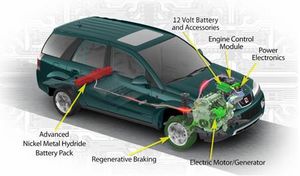.
Belt Alternator Starter (BAS): Difference between revisions
mNo edit summary |
No edit summary |
||
| Line 5: | Line 5: | ||
A sophisticated computer system controls an alternator/generator mated to the engine and turns off the conventional engine when in idle or deceleration. | A sophisticated computer system controls an alternator/generator mated to the engine and turns off the conventional engine when in idle or deceleration. | ||
[[Image:BAS Hybrid Diagram 1.jpg]] | |||
Most BAS-Hybrid systems also include [[Regenerative Braking|regenerative braking]] and optimized charging combined with an energy storage system (typically a 36-Volt NiMH [[Battery Technology|battery]]). This provides enhanced fuel economy while maintaining all vehicle accessories and passenger comfort systems during the periods when the engine is temporarily shut off. The stored electricity can then be used to restart the engine when the driver releases the brake pedal. | Most BAS-Hybrid systems also include [[Regenerative Braking|regenerative braking]] and optimized charging combined with an energy storage system (typically a 36-Volt NiMH [[Battery Technology|battery]]). This provides enhanced fuel economy while maintaining all vehicle accessories and passenger comfort systems during the periods when the engine is temporarily shut off. The stored electricity can then be used to restart the engine when the driver releases the brake pedal. | ||
Some BAS-hybrid systems, like the one developed for the [[Saturn VUE Green Line]], provide an electric motor boost during acceleration when needed. There can be as much as 110 lb-ft (150 Nm) of auto-start torque. For example, during an aggressive passing maneuver, the system will kick in and assist the engine in achieving maximum power. | Some BAS-hybrid systems, like the one developed for the [[Saturn VUE Green Line]], provide an electric motor boost during acceleration when needed. There can be as much as 110 lb-ft (150 Nm) of auto-start torque. For example, during an aggressive passing maneuver, the system will kick in and assist the engine in achieving maximum power. | ||
Revision as of 15:48, 11 July 2006
The Belt Alternator Starter or BAS-hybrid vehicle is a new trend in hybrid vehicles. This type of system is often referred to as a mild hybrid. Rather then have an expensive full hybrid system in a vehicle for maximum fuel economy, a relatively cheap BAS can be added to a vehicle line to make modest consumption reductions for a much lower price. For example, the Saturn VUE Green Line uses this system to gain a respectable 20% gain in fuel economy over the non-hybrid VUE.
A sophisticated computer system controls an alternator/generator mated to the engine and turns off the conventional engine when in idle or deceleration.
File:BAS Hybrid Diagram 1.jpg
Most BAS-Hybrid systems also include regenerative braking and optimized charging combined with an energy storage system (typically a 36-Volt NiMH battery). This provides enhanced fuel economy while maintaining all vehicle accessories and passenger comfort systems during the periods when the engine is temporarily shut off. The stored electricity can then be used to restart the engine when the driver releases the brake pedal.
Some BAS-hybrid systems, like the one developed for the Saturn VUE Green Line, provide an electric motor boost during acceleration when needed. There can be as much as 110 lb-ft (150 Nm) of auto-start torque. For example, during an aggressive passing maneuver, the system will kick in and assist the engine in achieving maximum power.

